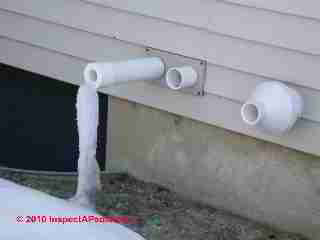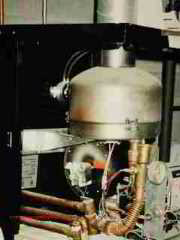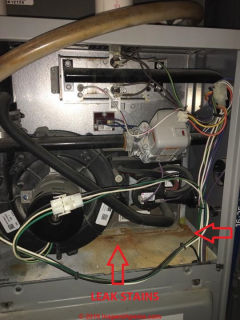 Condensing Boilers & Furnace Condensate Drains
Condensing Boilers & Furnace Condensate Drains
- POST a QUESTION or COMMENT about high efficiency heating boilers & condensing boilers: inspection, diagnosis, maintenance, & repair advice
High efficiency & condensing heating boiler condensate drainage piping & disposal guide:
Plumbing & heating codes & suggestions for disposal of condensate produced by high efficiency gas-fueled condensing boilers & furnaces.
This article series discusses the installation, operation & maintenance as well as defect inspections for high efficiency oil and gas fired heating boilers & furnaces, condensing boilers, and similar energy-saving equipment.
InspectAPedia tolerates no conflicts of interest. We have no relationship with advertisers, products, or services discussed at this website.
- Daniel Friedman, Publisher/Editor/Author - See WHO ARE WE?
Condensate Drain Specifications for High Efficiency & Condensing Gas Heating Equipment

Reader Question: proper piping materials for condensate from condensing furnaces or boilers
2017/01/11 Greig said:
Can a brass fitting be used to connect a condensing boiler flue condensate or will this corrode?
This question and answer were posted originally
at CHIMNEY WET TIME & CORROSION
Reply: use corrosion-resistant piping for condensate disposal
Condensate from condensing boilers is quite corrosive, a view shared by experts (Xinqiao 2006). That's why plastic is a good drain material. Stainless steel might be acceptable in some situations. I'd be careful about using brass, iron, copper, galvanized pipe.
While the manufacturer of the boiler would be the an authority on what is acceptable piping material for condensate disposal, model building codes say this, using ICC model building codes adopted by Virginia in the U.S. as an example:
SECTION 314 - CONDENSATE DISPOSAL
[M] 314.1 Fuel-burning appliances. Liquid combustion byproducts of condensing appliances shall be collected and discharged to an approved plumbing fixture or disposal area in accordance with the manufacturer’s installation instructions.
Condensate piping shall be of approved corrosion-resistant material and shall not be smaller than the drain connection on the appliance.
Such piping shall maintain a minimum horizontal slope in the direction of discharge of not less than 1/8 unit vertical in 12 units horizontal (1-percent slope).
[M] 314.2.1 Condensate disposal. Condensate from all
cooling coils and evaporators shall be conveyed from the
drain pan outlet to an approved place of disposal.
Condensate
shall not discharge into a street, alley or other areas so as
to cause a nuisance.
[M] 314.2.2 Drain pipe materials and sizes. Components
of the condensate disposal system shall be cast iron, galvanized
steel, copper, cross-linked polyethylene,
polybutylene, polyethylene, ABS, CPVC, or PVC pipe or
tubing. All components shall be selected for the pressure
and temperature rating of the installation.
Condensate waste
and drain line size shall not be less than 3/4-inch (19 mm)
internal diameter and shall not decrease in size from the
drain pan connection to the place of condensate disposal.
Where the drain pipes from more than one unit are
manifolded together for condensate drainage, the pipe or
tubing shall be sized in accordance with an approved
method.
All horizontal sections of drain piping shall be
installed in uniform alignment at a uniform slope.
Research on corrosion in condensing boiler condensate systems
- CHIMNEY WET TIME & CORROSION
- CONDENSATE DRAINS, CODES - home
- CONDENSING BOILERS/FURNACES DAMAGE
- CONDENSING GAS FURNACE INSPECTION & TESTS
- Chen, Qun, Karen Finney, Hanning Li, Xiaohui Zhang, Jue Zhou, Vida Sharifi, and Jim Swithenbank. "Condensing boiler applications in the process industry." Applied Energy 89, no. 1 (2012): 30-36.
Abstract excerpt:
Two technical barriers for the condensing boiler application are corrosion and return water temperatures. - DIRECT VENTS / SIDE WALL VENTS
- Moskovits, Peter. "Low-temperature boiler corrosion and deposits—a literature review." Industrial & Engineering Chemistry 51, no. 10 (1959): 1305-1312.
- PLUMBING CODE, General Regulations, Chapter 3, ICC MODEL PLUMBING CODE, [PDF], Virginia 2006 Plumbing Code, retrieved 2017/01/11, original source: https://www2.iccsafe.org/states/Virginia/Plumbing/PDFs/Chapter 203_General Regulations.pdf
Excerpt: The provisions of this chapter shall govern the general regulations regarding the installation of plumbing not specific to other chapters. - Xin-xin, P. A. N., and W. E. I. Dun-song. "Anti-corrosion of Condensing Gas Water Heater [J]." Gas & Heat 8 (2005): 002.
- Xinqiao, Zhang, Kou Guangxiao, Ye Yongjun, and Sun Shaochen. "Condensate Characteristic of Condensing Boiler and its Treatment [J]." Building Energy & Environment 1 (2006): 016.
Abstract excerpt:
Potential component of condensate from condensing boiler is analyzed in theoretic method.Combined the internal and overseas experimental result, the characteristic of condensate is analyzed from the point of quantity.
For achieving sevage emission standard, three treatments are put forward: dilution, oil absorption and medicament treatment, of which applied effect is analyzed.
...
Reader Comments, Questions & Answers About The Article Above
Below you will find questions and answers previously posted on this page at its page bottom reader comment box.
Reader Q&A - also see RECOMMENDED ARTICLES & FAQs
2020/03/31 common sources of condensate leak in high efficiency or condensing gas heating equipment
You ask why, in a condensing or high efficiency gas furnace, we see condensate dripping back into the heater.
[Annotations on photo are by InspectApedia.com - Ed.]
[Click to enlarge any image]
You cite condensate at the combustion air intake - which IMO is a bit unusual except for heaters that use a concentric air-intake + exhaust-outlet system.
Can you confirm how your heater gets its intake air and how its exahust is vented? Can you post a photo of the air inlet and exhaust outlet from outside the building (one photo per comment).
Please also post more detailed photos of the point where you think the leak is occurring.
You also pose the most-common explanations: improper pitch somewhere in the exhaust vent system, and improper exhaust vent termination (blocked, too close to ground, wind-impaired).
You also mention inadequate return air which is a clever and subtle potential explanation of exhaust vent problems: if there is inadequate return air it is possible that a vacuum is created near
*either* the combustion air intake (creating for gas fired appliances a high risk of unsafe carbon monoxide production)
*and/or* a vacuum near the exhaust vent that on gravity-vented or naturally-vented appliances draws exhaust gases out into the space around the heater
*or* for high-efficiency gas appliances, a nearby negative air pressure might draw condensate (and a small amount of exhaust gas) out of a small diameter drain opening or air intake or poorl-sealed flue joint where it could drip into the gas heater.
On a high efficiency gas appliance condensate may be disposed-of by draining back into a condensate drain for disposal into the building's DWV system. Condensate may also drip out of the exhaust termination but in freezing climates I've found this to be unsafe as ice build-up can block the exhaust.
See details at
DIRECT VENT INSTALLATION, SNAFUS & SPECS
and
CONDENSING BOILER/FURNACE CONDENSATE DRAIN
also
CLEARANCE REQUIREMENTS for Direct Vented Gas Appliances
On gas heaters that I've inspected and that had rust stains inside of the cabinet the most-common leak was at a gasket or joint on the exhaust line that was allowing condensate to escape into the unit instead of draining into the condensate drain that some units carry.
Following all of that speculation and review where are we?
We need a thorough, complete, detailed visual inspection of your specific gas heater by an experienced technician. In my experience a careful inspection (rarely some testing is needed) can find visual evidence of the leak source (by deposits if not actual condensate) by some common sense: water flows down-hill. Find the stains, look up and around to find the source.
I'd like to see more-detailed photos of the leak stains in your heater and of the components above and near that location.
2020/03/31 Tim said - Why does moisture sometimes come from the combustion air intake line on furnace
So, I’m unable to get an answer from anyone on this.
Why does moisture sometimes come from the combustion air intake line on furnace & cause rust & corrosion. It could be improper pitch, not enough return air, exterior terminations are to close to home...but nobody has a definitive answer. Any thoughts?
This Q&A were posted originally
On 2020-01-14 - by (mod) - black mold has been entering the Condensate Pump
Sounds like some kind of slime mold. It would be useful to track backwards to try to find the source. I suspect that you're going to want to clean and sanitize the system.
On 2020-01-14 by Rick
High Effficiency Condensing furnace 11 years old. In this last year, a black mold has been entering the Condensate Pump to the point of smothering it.
Replaced the pump and discharge line this Dec 16, 2019. Pump ran clear and in the last week, Algae again blackening the discharge line and is evident in pump reservoir. Pump discharges into laundry pump drain.
On 2019-07-24 - by (mod) -
That should be ok - be sure water drains away from the building not into it.
On 2019-07-24 by Chuck Goin
can I dispose of condensate from a gas fired furnace to the lawn area?
On 2018-11-15 by Clinton Blake
How far away from a well should condensed water drain ?
...
Continue reading at CONDENSING BOILERS/FURNACES or select a topic from the closely-related articles below, or see the complete ARTICLE INDEX.
Or see these
Recommended Articles
- CONDENSING BOILERS/FURNACES
- CONDENSING BOILERS/FURNACES DAMAGE
- CONDENSING BOILER/FURNACE CONDENSATE DRAIN
- DIRECT VENTS / SIDE WALL VENTS
- DIRECT VENT INSTALLATION, SNAFUS & SPECS
- SAFETY RECALLS CHIMNEYS VENTS HEATERS
Suggested citation for this web page
CONDENSING BOILER/FURNACE CONDENSATE DRAIN at InspectApedia.com - online encyclopedia of building & environmental inspection, testing, diagnosis, repair, & problem prevention advice.
Or see this
INDEX to RELATED ARTICLES: ARTICLE INDEX to HEATING BOILERS
Or use the SEARCH BOX found below to Ask a Question or Search InspectApedia
Ask a Question or Search InspectApedia
Questions & answers or comments about high efficiency heating boilers & condensing boilers: inspection, diagnosis, maintenance, & repair advice
Try the search box just below, or if you prefer, post a question or comment in the Comments box below and we will respond promptly.
Search the InspectApedia website
Note: appearance of your Comment below may be delayed: if your comment contains an image, photograph, web link, or text that looks to the software as if it might be a web link, your posting will appear after it has been approved by a moderator. Apologies for the delay.
Only one image can be added per comment but you can post as many comments, and therefore images, as you like.
You will not receive a notification when a response to your question has been posted.
Please bookmark this page to make it easy for you to check back for our response.
IF above you see "Comment Form is loading comments..." then COMMENT BOX - countable.ca / bawkbox.com IS NOT WORKING.
In any case you are welcome to send an email directly to us at InspectApedia.com at editor@inspectApedia.com
We'll reply to you directly. Please help us help you by noting, in your email, the URL of the InspectApedia page where you wanted to comment.
Citations & References
In addition to any citations in the article above, a full list is available on request.
- "Top Ten High Efficiency Gas Furnaces Based on Repair Frequency", in "#1 rated A/C & Heating System in the industry today? ", Merchantcircle.com, retrieved 4/3/12, source: http://www.merchantcircle.com/answers/q/91715/In-your-opinion--what- -would-you-say-is-the--1-rated-A-C---Heating-System-in-the-industry-today-
- Carrier Model BW9 Gas-Fired Condensing Boiler - Gas Fired Direct Vent Condensing Boiler - Example Installation & Operating Manual
- Our recommended books about building & mechanical systems design, inspection, problem diagnosis, and repair, and about indoor environment and IAQ testing, diagnosis, and cleanup are at the InspectAPedia Bookstore. Also see our Book Reviews - InspectAPedia.
- Fuel Oil & Oil Heating Magazine, 3621 Hill Rd., Parsippany, NJ 07054, 973-331-9545
- Domestic and Commercial Oil Burners, Charles H. Burkhardt, McGraw Hill Book Company, New York 3rd Ed 1969.
- "Residential Hydronic (circulating hot water) Heating Systems", Instructional Technologies Institute, Inc., 145 "D" Grassy Plain St., Bethel, CT 06801 800/227-1663 [home inspection training material] 1987
- "Warm Air Heating Systems". Instructional Technologies Institute, Inc., 145 "D" Grassy Plain St., Bethel, CT 06801 800/227-1663 [home inspection training material] 1987
- Boilers, Boiler Conversions, James E. Brumbaugh, ISBN 0-672-23389-4 (v. 1) Volume II, Oil, Gas, and Coal Burners, Controls, Ducts, Piping, Valves, James E. Brumbaugh, ISBN 0-672-23390-7 (v. 2) Volume III, Radiant Heating, Water Heaters, Ventilation, Air Conditioning, Heat Pumps, Air Cleaners, James E. Brumbaugh, ISBN 0-672-23383-5 (v. 3) or ISBN 0-672-23380-0 (set) Special Sales Director, Macmillan Publishing Co., 866 Third Ave., New York, NY 10022. Macmillan Publishing Co., NY
- In addition to citations & references found in this article, see the research citations given at the end of the related articles found at our suggested
CONTINUE READING or RECOMMENDED ARTICLES.
- Carson, Dunlop & Associates Ltd., 120 Carlton Street Suite 407, Toronto ON M5A 4K2. Tel: (416) 964-9415 1-800-268-7070 Email: info@carsondunlop.com. Alan Carson is a past president of ASHI, the American Society of Home Inspectors.
Thanks to Alan Carson and Bob Dunlop, for permission for InspectAPedia to use text excerpts from The HOME REFERENCE BOOK - the Encyclopedia of Homes and to use illustrations from The ILLUSTRATED HOME .
Carson Dunlop Associates provides extensive home inspection education and report writing material. In gratitude we provide links to tsome Carson Dunlop Associates products and services.


